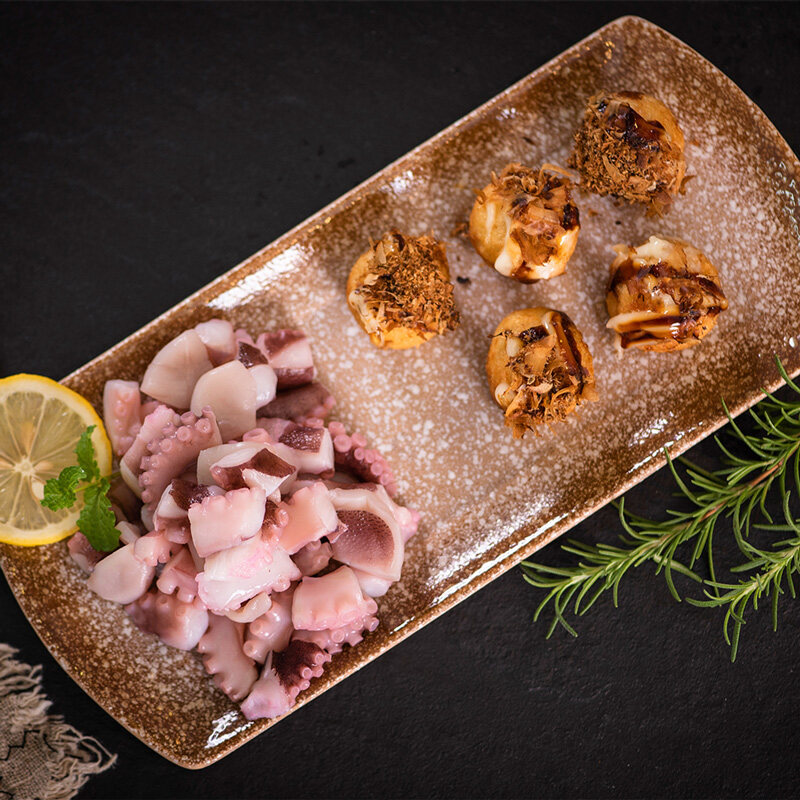Email cannot be empty
Password cannot be empty
Email format error
Email cannot be empty
Email already exists
6-20 characters(letters plus numbers only)
The password is inconsistent
Email format error
Email cannot be empty
Email does not exist
6-20 characters(letters plus numbers only)
The password is inconsistent

Octopus
Octopus
(22)Our frozen octopus has a variety of Matako, Iwatako, and Shimatako and is in good condition and meets safe export environment demands. All of them pass the certifications of IFS, ISO, BRC, HACCP, and KOSHER.
Selective products: Divided by the cutting and processing methods, here you can easily find Matako octopus cut, Iwatako octopus cut, and Shimatako octopus cut. For example, Matako is a boiled octopus, which is used in various sushi.
Divided by the cutting sizes, there will be octopus slices, octopus cuts, and octopus flowers, etc. Moreover, for convenience, we also prepare deep-processed octopus foods to wholesale demands, Japanese cooked octopus is our special menu.
Main ingredients: Pure IQF octopus in customized sizes and different processing degrees and parts.
Nutritional information - Raw octopus serving size:oz (85g)
Calories:70, Total Fat: 0.9g, Saturated Fat:0.2g, Polyunsaturated Fat:0.2g, Monounsaturated Fat: 0.1g, Cholesterol: 41mg, Sodium: 196mg, Potassium: 298mg,Total Carbohydrates: 1.9g, Dietary Fiber: 0g, Protein:13g
Vitamin A: 2.6%, Vitamin C: 7.1%, Calcium: 3.5%, Iron: 25%.
For reference only, nutritional data may differ slightly due to different cooking methods.
Area of use: Enjoy them however you like: grilled, sautéd, boiled, pan-fried, or simmered in soups.
Frozen Iwatako Octopus Cut
Always purchase extra octopus when you're out shopping. If you want to serve the octopus as the main course, you should budget about 1 pound per person because it will drastically diminish in size while cooking. Asking your preferred grocery store or fishmonger if they can order an octopus for you before you arrive is a fantastic idea. If frozen octopus is your only option (which is more usually the case), don't worry; the freezing procedure will produce a softer, fresher product after it has been thawed.
Frozen Shimatako Octopus Cut
Do you want to cook an entire octopus from start to finish in your home? then invest on a whole octopus. Want to enjoy octopus without having to deal with the inconvenience of preparation? Then you just need to do the most pleasurable part of the work—prepare it—after purchasing a grilled octopus.
Frozen Cooked Matako Octopus Slice
In order to ensure the highest quality, we make investments in the completeness of our procedures. We take care to every little detail during the manufacturing, production, and cooking processes of our octopus in order to preserve its original qualities and let you enjoy it as if it had just been plucked from the sea.
Frozen Pre Cooked Shimatako Octopus Slice
Uncommonly recognised, high-quality frozen octopuses are more delicate than fresh ones without needing extra processing. The suppleness of the octopus's muscles are compromised by pounding it, just as freezing is advantageous due of its low temperatures. Deep freezing also guarantees a high-quality mollusc by maintaining its nutritional qualities.
Frozen Octopus Salad Slice
In order to cook the frozen octopus precisely, care must be taken to prevent the meat from becoming too soft or flaky and from losing its compactness without stiffening. The frozen octopus is best prepared by dropping it into a skillet without much water and cooking it, then seasoning it with salt, oil, and chopped parsley. The frozen octopus may be cooked to perfection on a cast iron plate, giving it a wonderful, crispy texture.
Frozen Whole Octopus
Although octopus is a tasty, healthy, and lean fish, it can occasionally be difficult to cook. You may break down the tough muscle fibres and maintain the juiciness of the flesh by tenderising it beforehand and cooking the octopus in its own juices. This produces a moist and tender dish that isn't chewy. Octopus that has been frozen before is not more difficult to prepare than octopus that has just been caught.
Frozen Gutted Baby Octopus
The task of cooking octopus could appear scary to a chef lacking in self-assurance, but it isn't as difficult as you might imagine. In Italy, Spain, and Greece, it is referred to as polpo, pulpo, and oktapodi. The Japanese prefer tako, which can be eaten as sushi, sashimi, tako sunomono salad, or the well-known street dish takoyaki, which are fried octopus balls, yet the Spanish consume the most octopus in Europe.
Japanese Fried Octopus
This octopus is entire and has been packaged in a tray. Then it is tenderized after being cleaned and dissected. This type of octopus is typically a freeze-on-board octopus, meaning it is frozen as soon as it is caught by the fisherman. It travels from the boat to the processing facility where it is processed, defrosted, and then frozen once more. Compared to a day boat octopus, this product is less expensive and more plentiful.
Wholesale Frozen Octopus Cut
In order to cook the frozen octopus precisely, care must be taken to prevent the meat from becoming too soft or flaky and from losing its compactness without stiffening. The frozen octopus is best prepared by dropping it into a skillet without much water and cooking it, then seasoning it with salt, oil, and chopped parsley. The frozen octopus may be cooked to perfection on a cast iron plate, giving it a wonderful, crispy texture.
Frozen Octopus Tentacles
It is common to see octopus on restaurant menus and prepared in a variety of creative ways across Asia and the Mediterranean region. Due to its flavor and versatility, octopus pairs well with a wide range of other foods.










